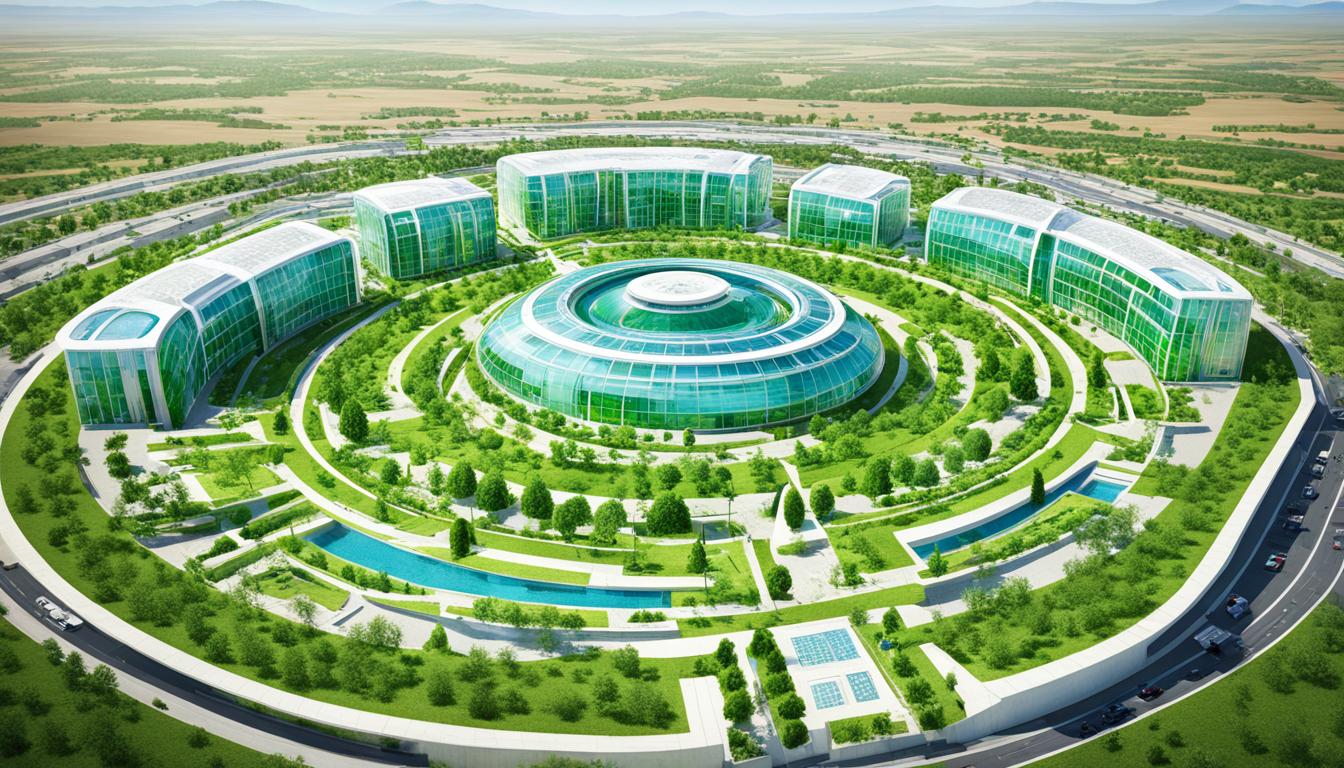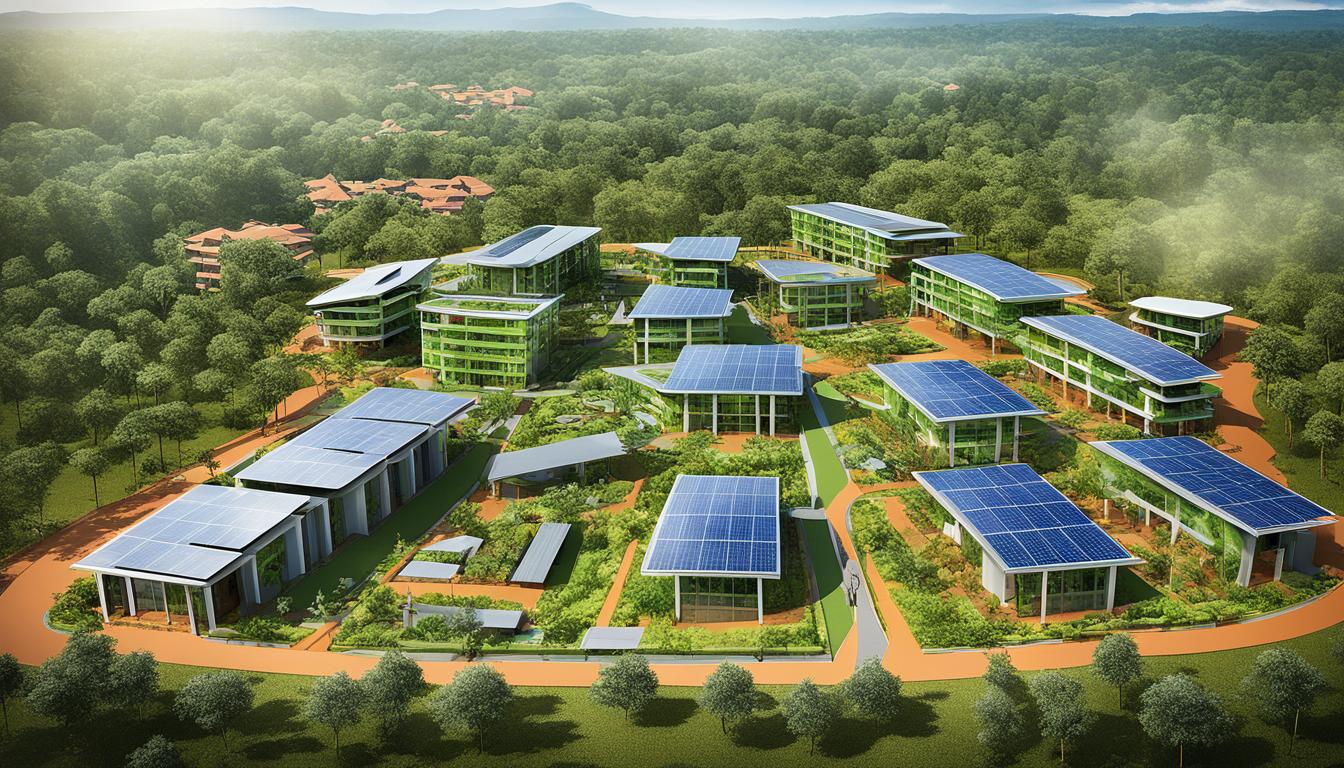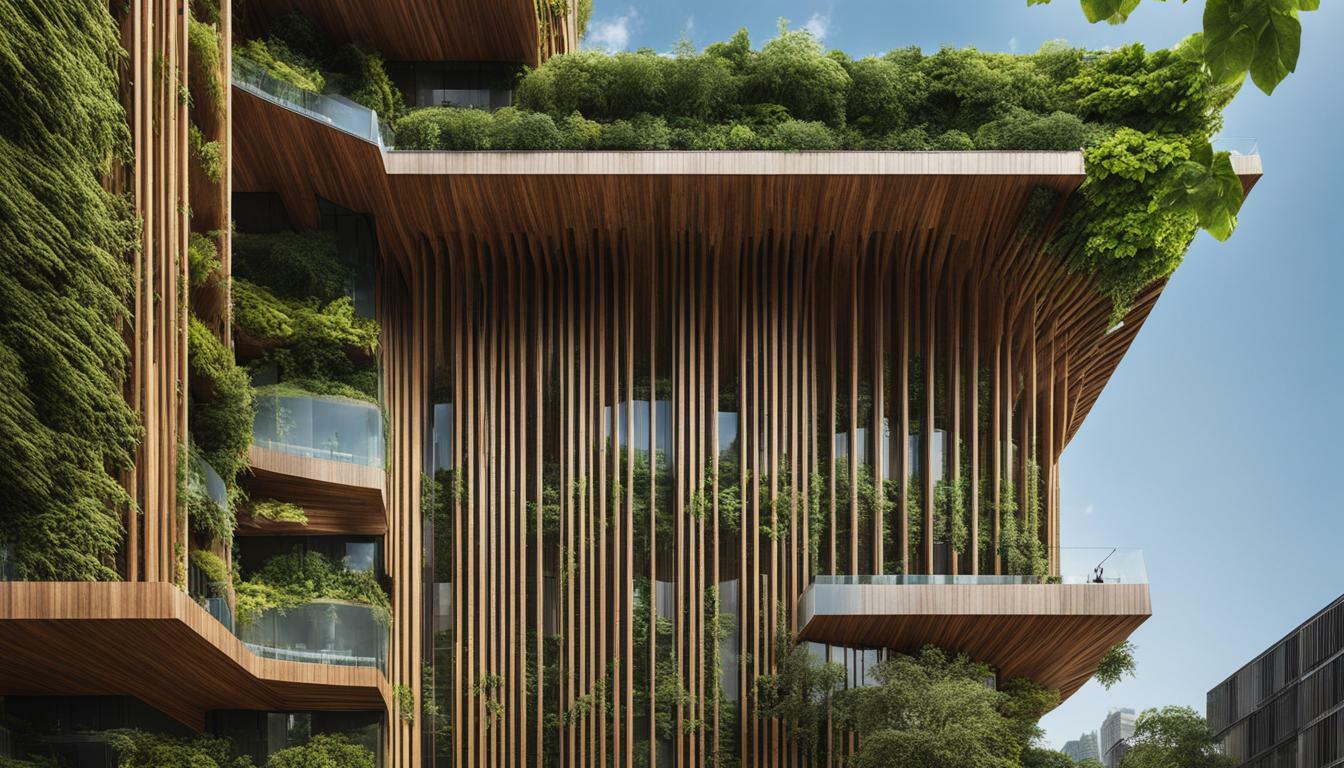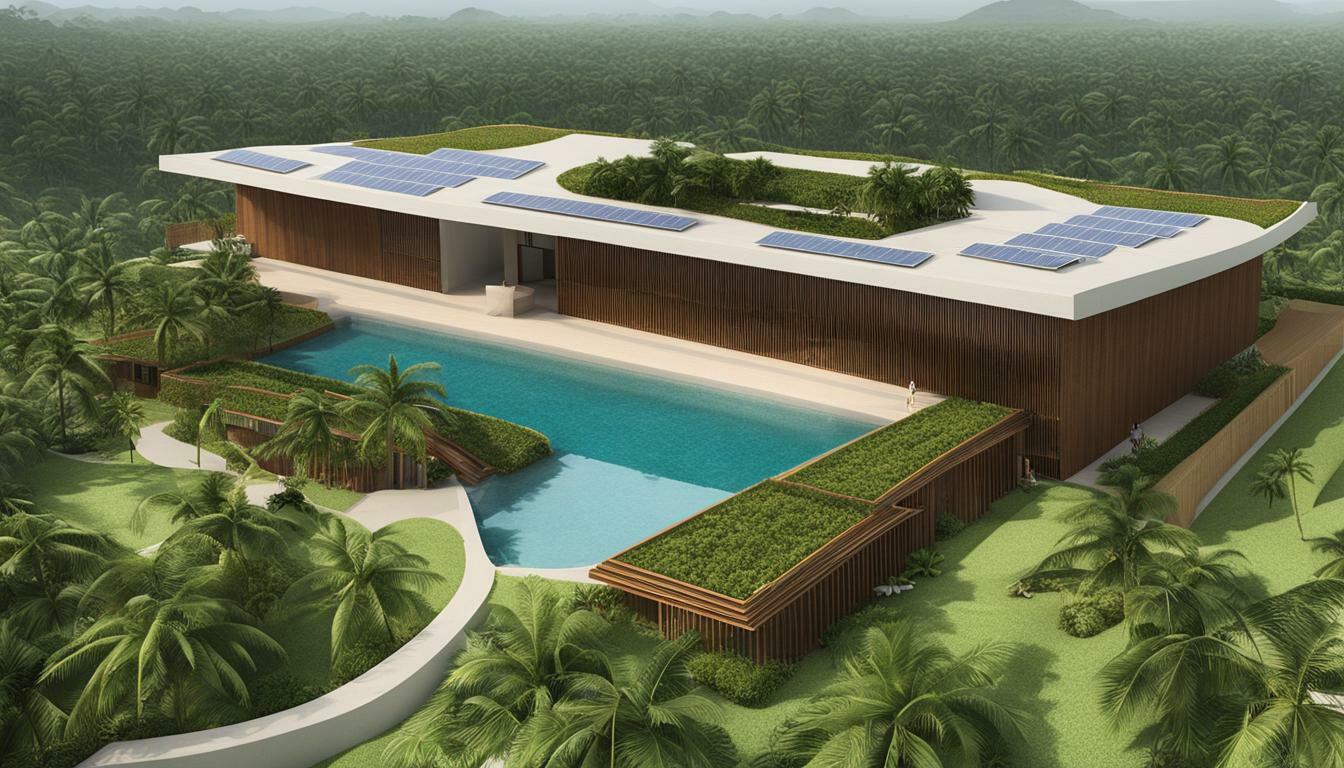Tuvalu Top Green Buildings
Tuvalu, a small island nation in the Pacific, is embracing sustainable infrastructure to protect its coastal areas and combat the challenges posed by climate change. With a focus on environmentally friendly buildings, energy-efficient construction, and eco-friendly architecture, Tuvalu is setting an example for the world in creating a greener future.
At the forefront of this green movement is the Tuvalu Coastal Adaptation Project (TCAP), an initiative aimed at enhancing coastal resilience and protecting vulnerable areas from the impacts of rising sea levels. Through the implementation of sustainable materials, renewable energy, and green construction practices, the project is creating a wave of change towards a more sustainable Tuvalu.
Key Takeaways:
- Tuvalu is implementing the Tuvalu Coastal Adaptation Project to enhance coastal resilience and protect vulnerable areas.
- The project incorporates sustainable materials, renewable energy, and green construction practices.
- Green buildings in Tuvalu offer multiple benefits, from reducing carbon emissions to creating a healthier living environment.
- Tuvalu’s commitment to green building design and certification demonstrates its dedication to sustainability.
- The educational impact of green buildings promotes sustainable practices and climate resilience in Tuvalu.
Coastal Protection for Funafuti, Nanumanga, and Nanumea Islands
The construction designs for coastal protection in Funafuti, Nanumanga, and Nanumea islands have been approved. The Tuvalu Coastal Adaptation Project (TCAP) is implementing a strategy of coastal measures to enhance coastal resilience in these areas. The project aims to protect the coastlines from wave attacks and erosion by implementing sustainable design and construction practices.
The designs have undergone rigorous consultation and scrutiny by multiple stakeholders, including the Government of Tuvalu, Nanumaga Island Council, and Nanumea Island Council, and have received their approvals.
To ensure the long-term sustainability and effectiveness of the coastal protection measures, the project incorporates components such as:
- Seawalls and revetments to prevent wave attacks
- Beach nourishment to combat erosion
- Reef restoration to enhance natural protection
- Mangrove planting for additional coastal resilience
These measures are designed to safeguard the islands’ vulnerable coastlines and communities from the impacts of climate change, such as rising sea levels and increased storm surges.
By implementing sustainable design and construction practices, the Tuvalu Coastal Adaptation Project is promoting the concept of coastal resilience in Tuvalu and contributing to the country’s long-term adaptation and mitigation efforts. The project is funded by the Green Climate Fund and managed by the UN Development Programme (UNDP).
This image provides a visual representation of the coastal protection measures implemented in Tuvalu, showcasing the importance of safeguarding the coastlines from wave attacks and erosion. The alt attribute of the image is “Coastal Protection in Tuvalu,” which aligns with the keyword related to this section.
Funafuti Coastal Adaptation Construction
The Funafuti coastal adaptation construction is a large-scale reclamation project that aims to protect the Vaiaku foreshore of Funafuti from wave attacks. It also includes the creation of new raised safe land on Fogafale, offering enhanced coastal resilience for the area.
The design of the reclamation project incorporates various coastal protection measures to withstand projected worst-case scenarios for sea level rise until 2100. These measures are essential in ensuring the long-term durability and environmental friendliness of the construction.
| Coastal Protection Measures: | Benefits: |
|---|---|
| Reclamation of the Vaiaku foreshore | Protects the shoreline from wave attacks |
| Creation of raised safe land on Fogafale | Provides additional security and safety |
| Incorporation of sustainable materials | Reduces environmental impact |
| Utilization of green construction practices | Promotes eco-friendly building methods |
The Funafuti coastal adaptation construction project is an integral part of the Tuvalu Coastal Adaptation Project (TCAP), which aims to enhance coastal resilience and protect vulnerable areas in Tuvalu. By implementing sustainable measures and innovative design, the project contributes to the country’s efforts in adapting to the impacts of climate change.
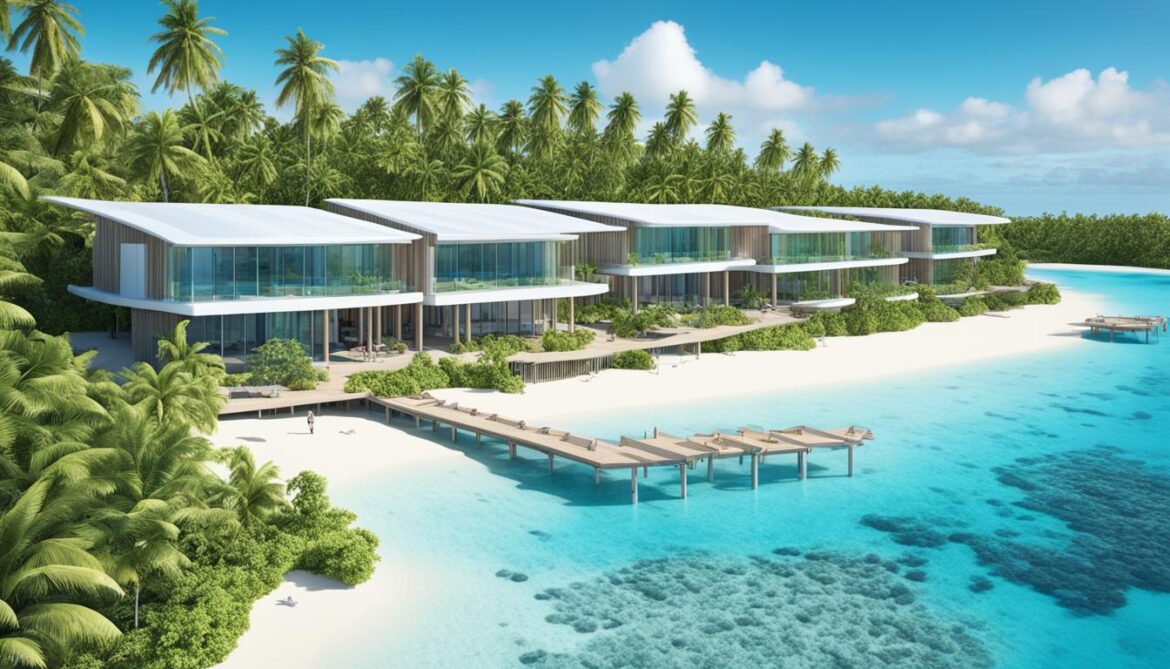
As depicted in the image above, the Funafuti coastal adaptation construction is an impressive undertaking that showcases Tuvalu’s commitment to coastal protection and sustainability. Through the use of green construction practices and the incorporation of sustainable materials, the project sets an example for other nations facing similar challenges.
Nanumaga Coastal Protection Design
The Nanumaga coastal protection design aims to safeguard the village from coastal hazards and enhance coastal resilience. This design includes the installation of Berm Top Barriers and the raising of the beach loading access ramp. The measures implemented are a result of thorough consultation with the community, ensuring that the design prioritizes the safety of the people and supports traditional handicraft activities by allowing easy access to the sea.
| Coastal Protection Measures | Benefits |
|---|---|
| Berm Top Barriers | Prevents wave attacks and erosion |
| Raised Beach Loading Access Ramp | Provides easy access to the sea for traditional handicraft activities |
The Nanumaga coastal design has been approved by the Leader of the Nanumaga Island Council and the Island Chief, ensuring that the protection measures align with the needs and aspirations of the community. By implementing these coastal measures in Nanumaga, Tuvalu takes a proactive approach to climate change adaptation and empowers the local population to thrive in the face of environmental challenges.
Nanumea Coastal Protection Design
The Nanumea coastal protection design incorporates a combination of effective measures to safeguard the church compound and the reef from coastal hazards. These measures include:
- Berm Top Barriers
- Sea Bee Wall revetment
- Reef Top Barriers
These coastal measures have been carefully designed and approved by the Nanumea Town Council Leader and the Island Chief to enhance the coastal resilience of Nanumea. By implementing these measures, the vulnerable areas will be shielded from potential wave attacks and erosion.

Tuvalu Coastal Adaptation Project Approval
The Tuvalu Coastal Adaptation Project (TCAP) has received approval from the Government of Tuvalu, Nanumaga Island Council, and Nanumea Island Council. The project is funded by the Green Climate Fund and managed by the UN Development Programme (UNDP). The approval of the project is an important step in enhancing coastal resilience in Tuvalu and protecting the country from the impacts of climate change. The project aims to implement sustainable and eco-friendly measures to mitigate coastal hazards.
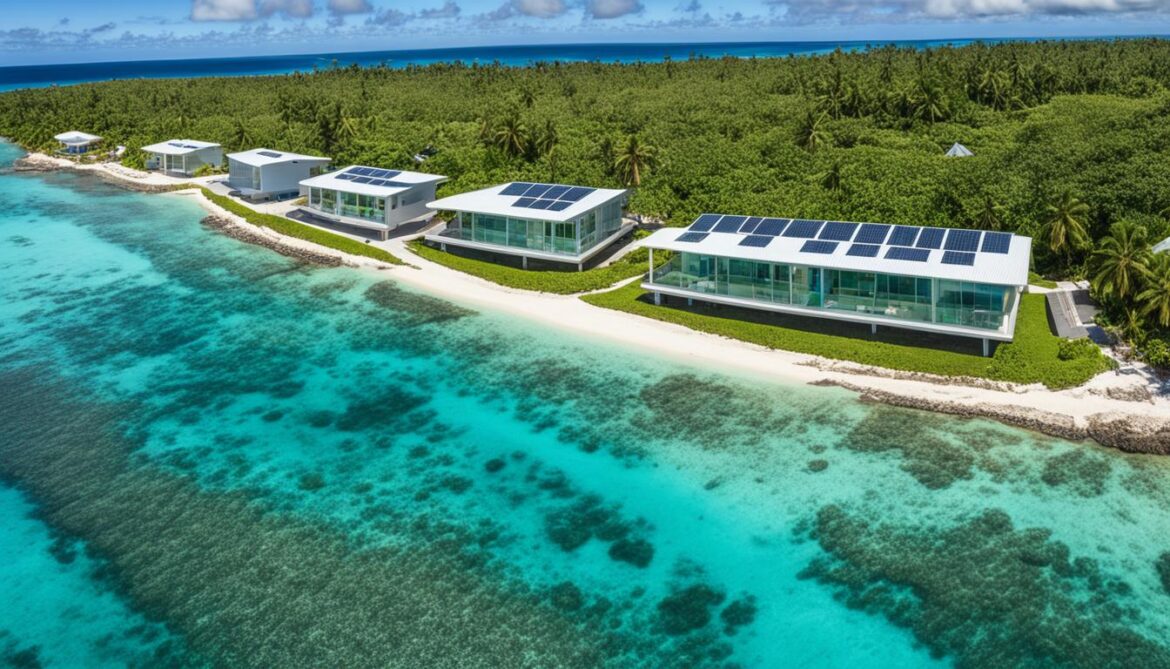
Coastal resilience plays a crucial role in ensuring the longevity and safety of coastal communities in the face of climate change. The Tuvalu Coastal Adaptation Project approval is a significant milestone in Tuvalu’s efforts to strengthen its coastal defenses and protect its vulnerable areas from rising sea levels and extreme weather events.
The approval of the Tuvalu Coastal Adaptation Project demonstrates the commitment of Tuvalu, the Green Climate Fund, and the UNDP to prioritize the protection of coastal communities and their resilience against climate change impacts. It showcases the importance of sustainable and eco-friendly measures in building a more resilient and sustainable future for Tuvalu.
The project involves the implementation of a range of measures, including the construction of coastal protection structures and the utilization of sustainable construction practices and materials. By integrating sustainable design principles, the project aims to mitigate coastal hazards while minimizing negative environmental impacts.
The approval of the Tuvalu Coastal Adaptation Project is a testament to the collaborative efforts and commitment of various stakeholders, including the government, local councils, and international organizations. Together, they strive to ensure the long-term viability and sustainability of Tuvalu’s coastal areas, protecting both the environment and the livelihoods of its people.
Through the implementation of the approved project, Tuvalu is taking a proactive approach in building coastal resilience and adapting to the challenges posed by climate change. The project serves as a model for other vulnerable coastal communities around the world, emphasizing the importance of investing in sustainable infrastructure and eco-friendly practices.
Sustainable Infrastructure in Tuvalu
The Tuvalu Coastal Adaptation Project (TCAP) serves as a prime example of sustainable infrastructure in Tuvalu. This project exemplifies the integration of green construction practices and renewable energy technologies to enhance coastal resilience and protect vulnerable areas from climate change impacts. By prioritizing the use of sustainable materials and implementing energy-efficient design principles, Tuvalu’s buildings and infrastructure contribute to a greener future.
The incorporation of green construction practices ensures that the development of infrastructure in Tuvalu aligns with environmentally friendly standards. From the choice of materials to the implementation of energy-efficient design principles, every aspect is carefully considered to minimize the ecological footprint.
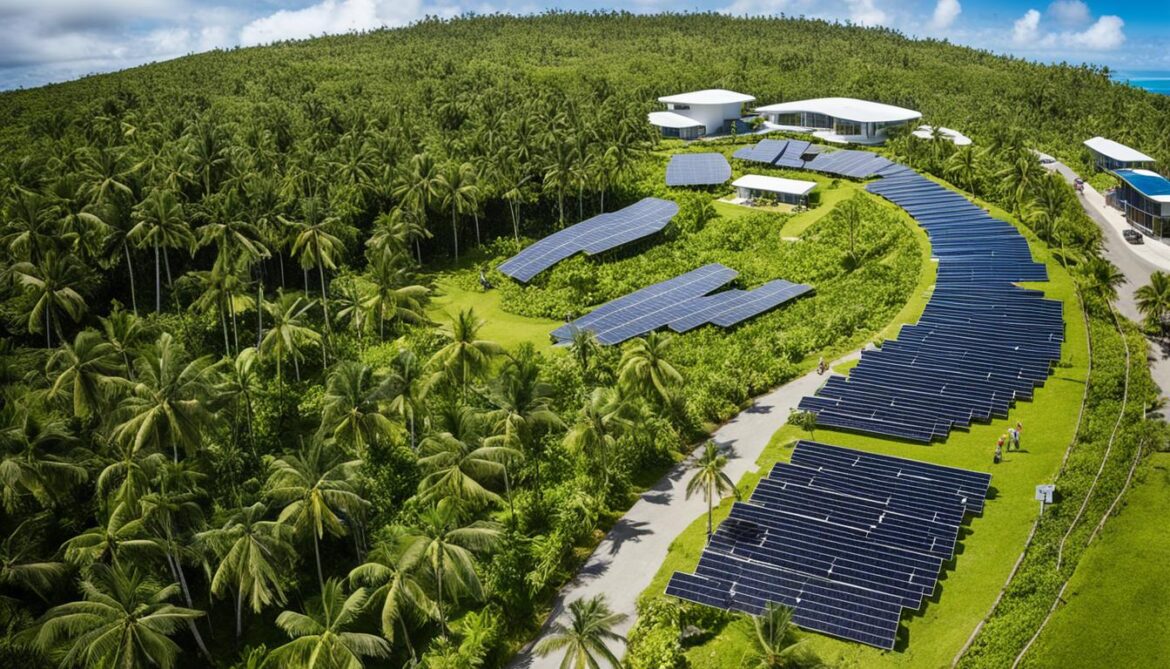
Developing sustainable infrastructure in Tuvalu paves the way for a more resilient and eco-conscious nation.
Renewable energy buildings form a significant part of Tuvalu’s sustainable infrastructure. By harnessing renewable energy technologies, such as solar power or wind turbines, these buildings reduce dependency on fossil fuels and contribute to a more sustainable energy future. Embracing such innovations bolsters Tuvalu’s commitment to combat climate change and promote a greener environment.
Benefits of Sustainable Infrastructure in Tuvalu
The implementation of sustainable infrastructure in Tuvalu offers numerous benefits that extend beyond environmental preservation. These include:
- Reduced carbon emissions through energy-efficient design
- Conservation of natural resources through the use of sustainable materials
- Promotion of clean and renewable energy sources
- Improved energy efficiency, resulting in long-term cost savings
- Creation of healthier living environments for communities
Sustainable infrastructure in Tuvalu builds the foundation for a more resilient and environmentally conscious future. By integrating green construction practices and renewable energy technologies, Tuvalu sets an inspiring example for other nations to emulate.
| Benefits of Sustainable Infrastructure in Tuvalu | Key Points |
|---|---|
| Reduced carbon emissions | Energy-efficient design minimizes environmental impact. |
| Conservation of resources | Sustainable materials contribute to resource preservation. |
| Promotion of clean energy | Renewable energy technologies reduce reliance on fossil fuels. |
| Long-term cost savings | Energy efficiency leads to reduced utility expenses. |
| Healthier living environments | Sustainable infrastructure provides improved indoor air quality. |
Benefits of Green Buildings in Tuvalu
Green buildings in Tuvalu offer several benefits. They contribute to the country’s efforts in mitigating climate change by reducing carbon emissions through energy-efficient design and renewable energy integration.
By incorporating energy-efficient systems and technologies, green buildings in Tuvalu reduce the reliance on fossil fuels and lower energy consumption. This not only helps to conserve natural resources but also reduces greenhouse gas emissions, contributing to a cleaner and healthier environment.
Furthermore, green buildings prioritize the use of sustainable materials, minimizing the impact on the environment. From the construction phase to the end of the building’s lifecycle, environmentally friendly buildings in Tuvalu aim to reduce waste, conserve water, and improve indoor air quality.
The improved indoor environment of green buildings promotes occupant health and well-being. With features such as better ventilation, natural lighting, and the use of non-toxic materials, occupants can enjoy a healthier and more productive living and working environment.
Green buildings in Tuvalu play a significant role in advancing sustainability and creating a greener future for the country.
By setting an example of energy-efficient construction practices and environmentally conscious design, green buildings in Tuvalu serve as a catalyst for change in the construction industry. They inspire innovation, promote sustainable development, and contribute to the overall resilience of the country against the impacts of climate change.
Benefits of Green Buildings in Tuvalu
- Reduces carbon emissions and mitigates climate change
- Lower energy consumption and reliance on fossil fuels
- Conserves natural resources and uses sustainable materials
- Improves indoor air quality and occupant health
The following table highlights the key benefits of green buildings in Tuvalu:
| Benefits | Description |
|---|---|
| Reduced carbon emissions | Energy-efficient design and renewable energy integration contribute to lower carbon footprint. |
| Energy savings | Green buildings reduce energy consumption and lower utility costs. |
| Sustainable materials | Environmentally friendly buildings prioritize the use of sustainable materials, reducing environmental impact. |
| Improved indoor air quality | Natural ventilation and non-toxic materials create a healthier indoor environment for occupants. |
| Enhanced occupant comfort | Green buildings incorporate features like natural lighting and temperature control systems, improving comfort levels. |
| Water conservation | Efficient water fixtures and management systems reduce water consumption and promote conservation. |
With these numerous benefits, green buildings in Tuvalu not only contribute to a sustainable future but also provide a higher quality of life for occupants and the wider community.
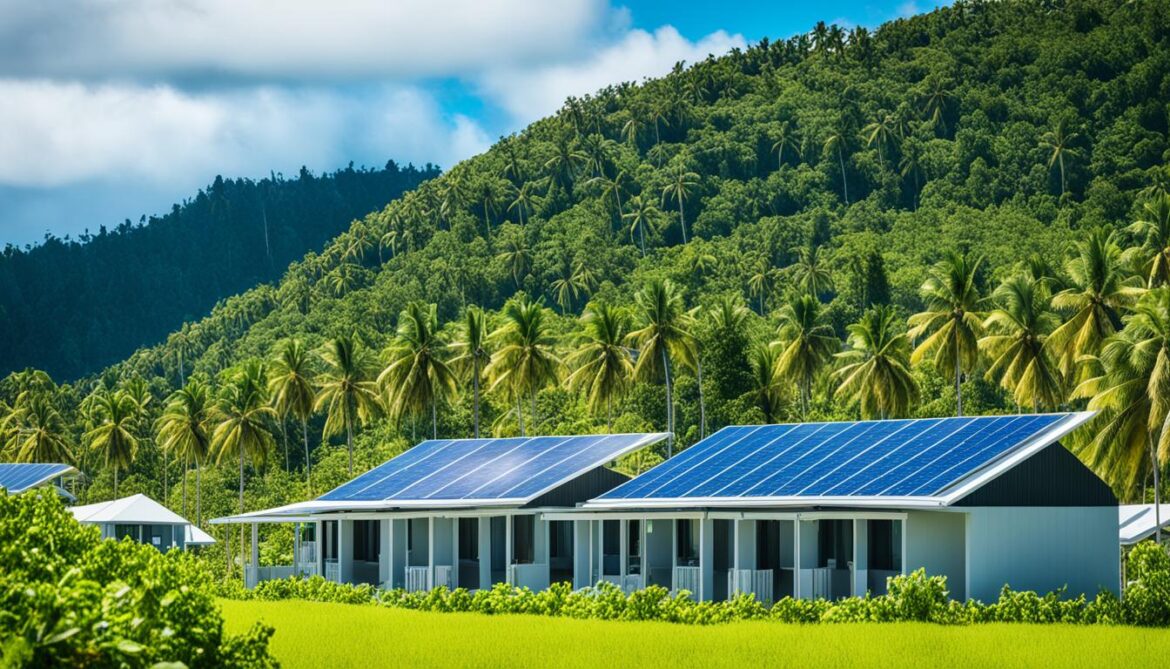
The Role of Certification in Green Building Design
Green building certification plays a crucial role in ensuring that buildings in Tuvalu meet sustainable design and construction standards. Certification programs provide a framework for evaluating the environmental performance of buildings and promoting sustainable building practices. They help set benchmarks for energy efficiency, water conservation, indoor air quality, and the use of sustainable materials. Green building certification in Tuvalu not only ensures that buildings adhere to eco-friendly architecture principles but also contributes to the country’s sustainability goals.
By obtaining green building certification, architects, developers, and building owners in Tuvalu demonstrate their commitment to sustainable building practices. The certification process involves a thorough assessment of various aspects of building design, construction, and operation. This evaluation helps identify opportunities for improvement and promotes the adoption of eco-friendly technologies and practices.
Green building certification in Tuvalu encourages the implementation of sustainable materials and construction techniques. It promotes the use of renewable energy sources, such as solar power, and encourages the efficient use of resources, including water and electricity. By incorporating these sustainable practices into the design and construction process, buildings in Tuvalu can minimize their environmental impact and contribute to the overall sustainability of the nation.
Benefits of Green Building Certification
Green building certification offers numerous benefits for both building owners and occupants. By achieving certification, buildings can:
- Reduce energy consumption and lower operating costs
- Improve indoor air quality and provide a healthier living environment
- Enhance water efficiency and reduce water usage
- Minimize waste generation and promote recycling
- Promote the use of sustainable materials and support local economies
- Attract tenants and buyers who prioritize sustainability
- Contribute to a greener and more sustainable future
Furthermore, green building certification helps Tuvalu in its efforts to address climate change and build resilience against its impacts. Sustainable building practices and eco-friendly architecture contribute to reducing carbon emissions and mitigating the effects of global warming. They also help protect Tuvalu’s natural resources and ecosystems, ensuring their long-term sustainability.
| Green Building Certification in Tuvalu | Certification Programs |
|---|---|
| Tuvalu Green Building Certification (TGBC) | Tuvalu Green Rating System (TGRS) |
| Green Star Tuvalu | Leadership in Energy and Environmental Design (LEED) |
| Tuvalu Sustainable Building Certificate (TSBC) | Building Research Establishment Environmental Assessment Method (BREEAM) |
Note: The table above provides examples of green building certification programs in Tuvalu.
Green building certification plays a vital role in transforming the construction industry towards sustainable and eco-friendly practices. It encourages architects, developers, and building owners to embrace sustainable building principles and contribute to a greener future. Through green building certification, Tuvalu can continue its journey towards sustainable infrastructure and eco-friendly architecture, ensuring a resilient and sustainable built environment for generations to come.
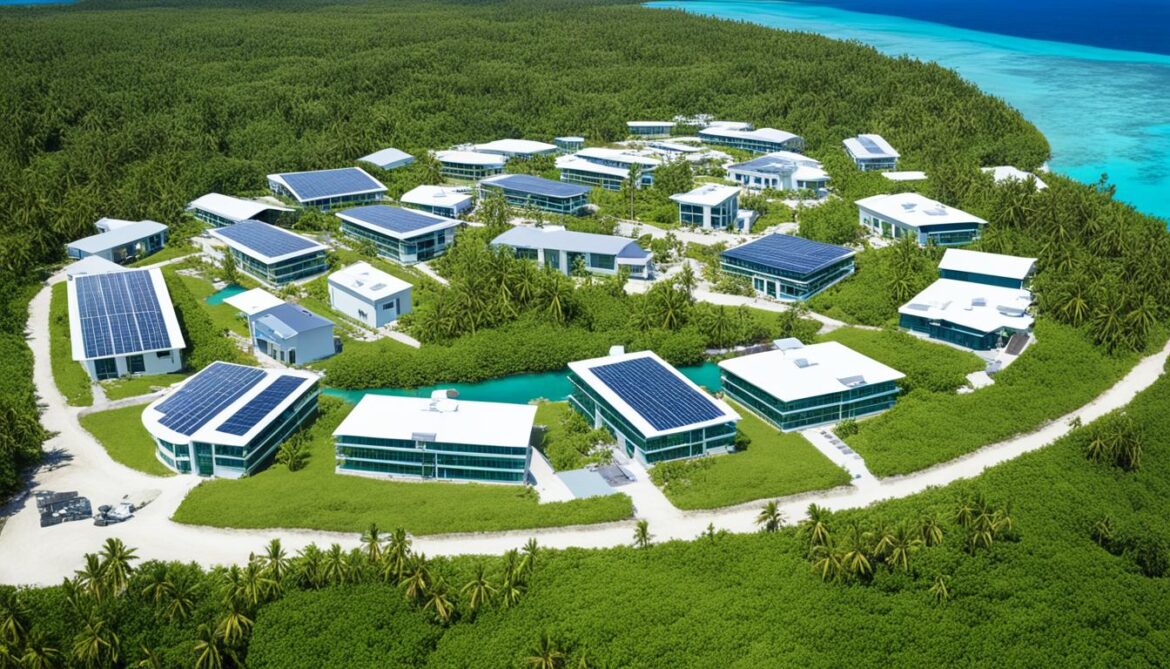
Tuvalu’s Renewable Energy Initiative
Tuvalu is actively promoting renewable energy through initiatives such as the Renewable Energy, Energy Efficiency Master Plan. The plan aims to convert the country’s power generation from diesel-based to 100% renewable electricity by 2020. As part of this initiative, Tuvalu is building a renewable energy fale that showcases the benefits of living in a home with green technology. The fale will feature energy-efficient appliances and serve as an educational tool to promote the adoption of renewable energy and energy-efficient practices in Tuvalu.
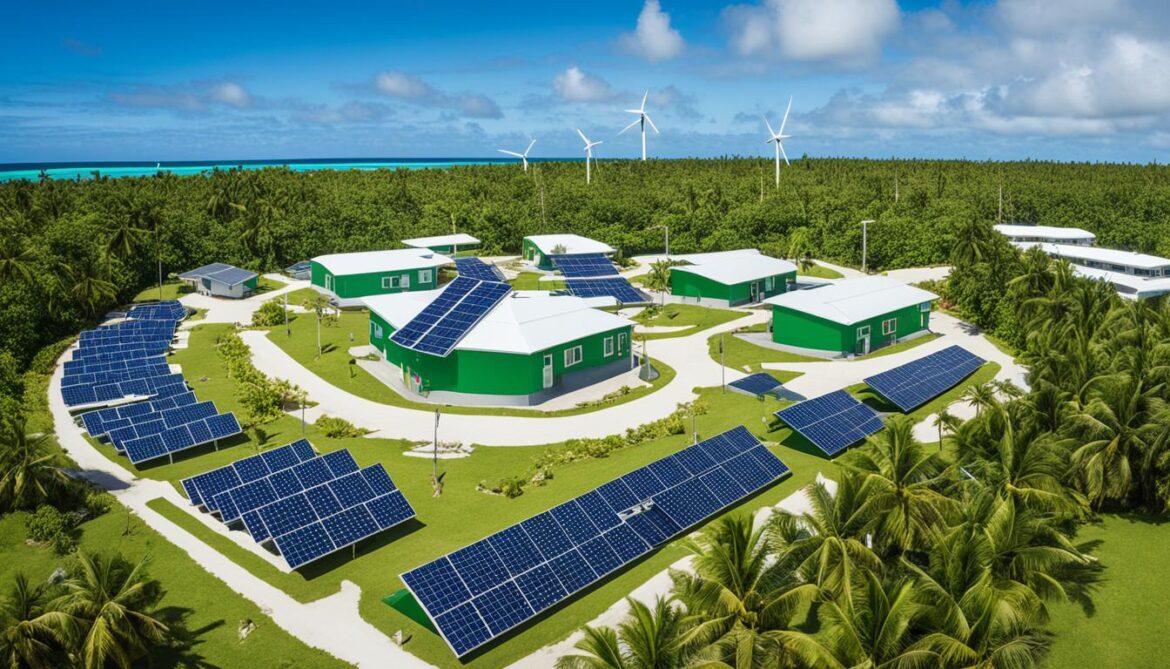
The Benefits of Renewable Energy
Renewable energy plays a crucial role in transforming Tuvalu into a sustainable and environmentally friendly nation. By transitioning to renewable electricity, Tuvalu can significantly reduce its carbon footprint and dependence on imported fossil fuels. This shift will not only help combat climate change but also improve energy security and reduce energy costs for the local population.
The Importance of Energy-Efficient Appliances
Energy-efficient appliances are key to maximizing the benefits of renewable energy in Tuvalu. By using appliances that consume less energy, households can minimize their electricity consumption and increase the overall efficiency of the renewable energy system. This, in turn, leads to reduced energy bills and a more sustainable lifestyle.
Promoting Green Technology in Tuvalu
Green technology encompasses a wide range of practices and innovations that promote sustainability and environmental protection. In Tuvalu, the adoption of green technology, such as solar panels and energy-efficient appliances, can contribute to the country’s goal of achieving 100% renewable electricity. It not only improves the quality of life for the Tuvaluan people but also serves as an example for other nations striving to create a greener future.
Renewable Energy and Sustainable Development
The development of renewable energy infrastructure aligns with Tuvalu’s commitment to sustainable development. By harnessing the power of natural resources like sunlight and wind, Tuvalu can reduce its carbon emissions, protect the environment, and create a more resilient future for its citizens. The Renewable Energy, Energy Efficiency Master Plan sets the stage for Tuvalu’s sustainable development efforts and serves as a blueprint for other nations facing similar challenges.
The Future of Renewable Energy in Tuvalu
Tuvalu’s renewable energy initiative marks a significant step towards achieving a greener and more sustainable future. By leveraging renewable resources and embracing energy-efficient practices, Tuvalu is leading the way in the Pacific region’s fight against climate change. The renewable energy fale serves as a beacon of hope and inspiration, demonstrating the tangible benefits of renewable energy and encouraging communities to embrace a more sustainable lifestyle.
| Benefits of Tuvalu’s Renewable Energy Initiative |
|---|
| Promotes sustainability and environmental protection |
| Reduces carbon emissions and dependence on fossil fuels |
| Improves energy security and reduces energy costs |
| Encourages adoption of energy-efficient appliances |
| Serves as a blueprint for sustainable development in Tuvalu and beyond |
Educational Impact of Green Buildings in Tuvalu
Green buildings in Tuvalu play a crucial role in not only enhancing the country’s climate resilience but also educating the community about sustainable practices. These eco-friendly structures provide valuable opportunities for people to learn about the benefits of living in environmentally conscious environments.
One notable example of a green building in Tuvalu is the renewable energy fale. This innovative construction allows individuals to observe and experience firsthand the positive impact of sustainable design and technology. It serves as a living educational tool, demonstrating the effectiveness of renewable energy integration, energy-efficient systems, and the use of sustainable materials.
Furthermore, green buildings contribute to the education of school children, fostering a deeper understanding of the importance of climate resilience and sustainable practices. By incorporating green building concepts into their curriculum, schools can teach students about the connection between sustainable design, environmental stewardship, and building a sustainable future for Tuvalu.
Green buildings in Tuvalu inspire and empower individuals to adopt sustainable practices, contributing to a more environmentally conscious and climate-resilient society. The educational impact extends beyond the structures themselves, creating a culture of sustainability that reverberates throughout the community.
Through interactive displays, workshops, and educational programs hosted within green buildings, individuals of all ages can gain knowledge about sustainable practices in Tuvalu. They learn about reducing energy consumption, conserving water resources, promoting biodiversity, and adopting sustainable waste management strategies. By nurturing a sense of environmental responsibility, green buildings in Tuvalu foster a collective commitment to sustainable living.
The Benefits of Green Building Education
Green building education in Tuvalu offers several benefits to individuals and the broader community. It empowers individuals to make informed decisions about sustainable practices, enabling them to lead more environmentally friendly lives. Through this education, individuals can learn how their choices can positively impact not only their immediate environment but also the global climate.
Furthermore, green building education promotes awareness of the importance of climate resilience in Tuvalu. It highlights the vulnerabilities faced by low-lying island nations and encourages proactive measures to mitigate the effects of climate change. By understanding the link between sustainable practices, climate resilience, and the preservation of Tuvalu’s unique culture and way of life, individuals are motivated to take action.
Overall, the educational impact of green buildings in Tuvalu goes beyond the physical structures. It fosters a deeper understanding of sustainable practices, encourages behavior change, and empowers individuals to contribute to the resilience and sustainability of their communities.
The Role of Education in Building a Sustainable Future for Tuvalu
Education is a critical tool in building a sustainable future for Tuvalu. By incorporating green building education into schools, community centers, and public spaces, Tuvalu can nurture a generation of environmentally conscious individuals who are equipped with the knowledge and skills to address the challenges of climate change.
Green building education also promotes the adoption of sustainable practices in Tuvalu’s construction industry. By training architects, engineers, and builders in green building design principles, the country can develop a local workforce that is skilled in sustainable construction techniques. This not only supports the growth of Tuvalu’s green building sector but also ensures that future construction projects prioritize environmental sustainability.
Furthermore, green building education can serve as a catalyst for innovation and the development of sustainable technologies in Tuvalu. By inspiring individuals to think creatively about sustainable design and renewable energy integration, education can drive local solutions to the unique challenges faced by the island nation.
Together, green building education and sustainable practices in Tuvalu can pave the way for a resilient, environmentally conscious future. By fostering a culture of sustainability and equipping individuals with the knowledge to make informed choices, Tuvalu can take significant strides towards building a more sustainable and climate-resilient society.
Conclusion
The implementation of green buildings and sustainable infrastructure in Tuvalu, as demonstrated by the Tuvalu Coastal Adaptation Project and the renewable energy fale, is crucial in enhancing the country’s resilience to climate change. These initiatives promote eco-friendly design and construction practices, renewable energy integration, and the use of sustainable materials.
Green buildings not only protect the vulnerable areas from coastal hazards but also provide multiple benefits, from reducing carbon emissions to creating a healthier and more sustainable living environment. Tuvalu’s commitment to green building design and sustainable practices sets an example for other nations facing the challenges of climate change in the Pacific region.
By prioritizing sustainable infrastructure in Tuvalu, the country is making a significant contribution to global efforts in combating climate change. The Tuvalu Top Green Buildings, with their environmentally friendly and energy-efficient construction, not only ensure the safety and wellbeing of the communities but also pave the way towards a greener and more sustainable future for Tuvalu.




